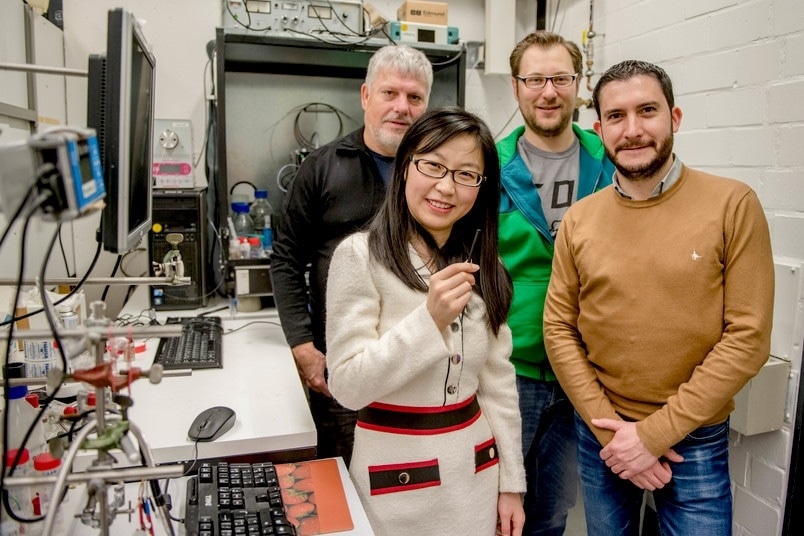Apr 29 2019
Efficient and cheap energy conversion devices are developed using proteins that take part in the process of photosynthesis.
 Wolfgang Schuhmann, Fangyuan Zhao, Adrian Ruff, and Felipe Conzuelo (from the left) work on long-lasting bioelectrodes. (Image credit: © RUB, Marquard)
Wolfgang Schuhmann, Fangyuan Zhao, Adrian Ruff, and Felipe Conzuelo (from the left) work on long-lasting bioelectrodes. (Image credit: © RUB, Marquard)
Despite the sturdy nature of proteins like photosystem I, the use of isolated protein complexes included in the semi-artificial electrodes is related to significantly short stability in the long run. As a result, the technological use of these types of biodevices is still scanty.
Scientists at Ruhr-Universität Bochum (RUB) demonstrated that the key to attaining high stability is to carefully operate the photosystem-based bioelectrode in the absence of oxygen.
The research team including Dr Fangyuan Zhao, Dr Adrian Ruff, Dr Felipe Conzuelo, and Professor Wolfgang Schuhmann from the Chair of Analytical Chemistry and Center for Electrochemical Sciences, in collaboration with Professor Matthias Rögner from the Bochum Chair of Plant Biochemistry, has reported the study outcomes in the Journal of the American Chemical Society.
Using Green Energy
At present, the efficient production of energy for a more sustainable society is a constant challenge. Hence, understanding and overcoming the processes that presently control the lifetime of technologies for the conversion of renewable and green energy are important. Among various methods with high potential, the use of protein complexes that take part in the photosynthetic process for the semi-artificial device manufacture has gained significant attention owing to their large natural availability and high efficiency.
Oxygen is to Blame
The researchers have reported in their earlier study that during the operation of the bioelectrode, the reactive molecules are produced, which have an adverse effect on photosystem I and lead to a restricted lifetime of the biodevice. These reactive molecules are associated with oxygen use as the end electron acceptor. Hence, the development of bioelectrodes working in an oxygen-free environment was proposed.
An Important Step Toward the Application
Currently, the working of the bioelectrode in the absence of oxygen has been shown to increase the lifetime of the device significantly for a considerable period of time than with the results obtained in the presence of atmospheric oxygen. It is explained by the authors that the obtained results are a key step with respect to the efficient development and feasible application of photobiodevices for the conversion of energy.
Funding
This study was financially supported by the German Research Foundation as part of the Cluster of Excellence RESOLV (EXC 2033, Project Number 390677874) and the German-Israeli project cooperation as part of the project “Nanoengineered optoelectronics with biomaterials and bioinspired assemblies.”